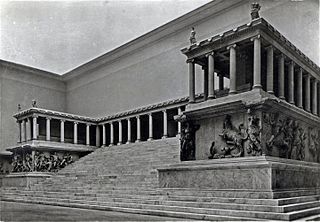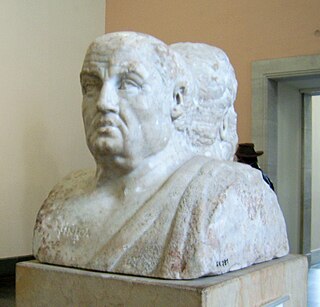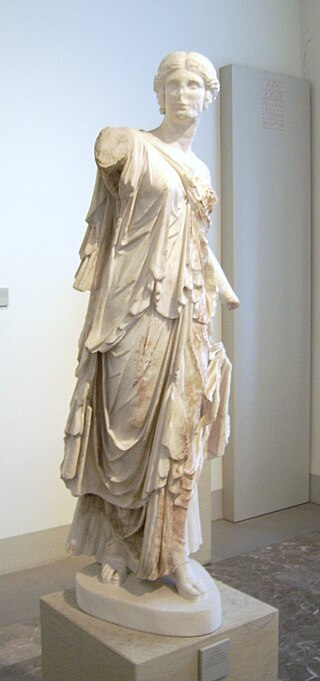
The Pergamon Museum is a listed building on the Museum Island in the historic centre of Berlin, Germany. It was built from 1910 to 1930 by order of Emperor Wilhelm II and according to plans by Alfred Messel and Ludwig Hoffmann in Stripped Classicism style. As part of the Museum Island complex, the Pergamon Museum was added to the UNESCO World Heritage List in 1999 because of its architecture and testimony to the evolution of museums as architectural and social phenomena.

The Pergamon Altar was a monumental construction built during the reign of the Ancient Greek King Eumenes II in the first half of the 2nd century BC on one of the terraces of the acropolis of Pergamon in Asia Minor.

The Altes Museum is a listed building on the Museum Island in the historic centre of Berlin, Germany. Built between 1825 and 1830 by order of King Frederick William III of Prussia according to plans by Karl Friedrich Schinkel, it is considered a major work of German Neoclassical architecture. It is surrounded by the Berlin Cathedral to the east, the Berlin Palace to the south and the Zeughaus to the west. Currently, the Altes Museum houses the Antikensammlung and parts of the Münzkabinett. As part of the Museum Island complex, the Altes Museum was listed as a UNESCO World Heritage Site in 1999, in recognition of its testimony to the development of the museum as a social and architectural phenomenon.
The Antikensammlung Berlin is one of the most important collections of classical art in the world, now held in the Altes Museum and Pergamon Museum in Berlin, Germany. It contains thousands of ancient archaeological artefacts from the ancient Greek, Roman, Etruscan and Cypriot civilizations. Its main attraction is the Pergamon Altar and Greek and Roman architectural elements from Priene, Magnesia, Baalbek and Falerii. In addition, the collection includes a large number of ancient sculptures, vases, terracottas, bronzes, sarcophagi, engraved gems and metalwork.

The oinochoe by the Shuvalov Painter in the collection of Antikensammlung Berlin is an erotic depiction from ancient Greek vase painting.

Alexander Christian Leopold Conze was a German archaeologist, who specialized in ancient Greek art.

The Berlin Foundry Cup is a red-figure kylix from the early 5th century BC. It is the name vase of the Attic vase painter known conventionally as the Foundry Painter. Its most striking feature is the exterior depiction of activities in an Athenian bronze workshop or foundry. It is an important source on ancient Greek metal-working technology.

The Grave relief for Eutaxia and Artemisios is a Hellenistic grave relief in the antique collection of the Museum August Kestner in Hannover.
The statuette of Aphrodite known as Aphrodite Heyl in the Antikensammlung Berlin is an especially finely worked terracotta statue from the second century BC.

The Double Herm of Socrates and Seneca is an ancient Roman statue from the first half of the third century AD. The herm depicts the Greek philosopher Socrates on one side, and the Roman Stoic Seneca the Younger on the other. It currently belongs to the Antikensammlung Berlin, found in the Altes Museum.

The Fragment from the tomb of Nikarete from the third quarter of the fourth century BC, found near Athens is displayed today in the Antikensammlung of the Altes Museum in Berlin.
The Neck Amphora by Exekias is a neck amphora in the black figure style by the Attic vase painter and potter Exekias. It is found in the possession of the Antikensammlung Berlin under the inventory number F 1720 and is on display in the Altes Museum. It depicts Herakles' battle with the Nemean lion on one side and the sons of Theseus on the other. The amphora could only be restored for the first time almost a hundred and fifty years after its original discovery due to negligence and political difficulties.

A Relief depicting a Roman legionary is located in the Pergamonmuseum and belongs to the Antikensammlung Berlin. The relief was created at the end of the first century AD and was discovered in 1800 at Pozzuoli.
Max Kunze is a German classical archaeologist.

The Grave relief of Publius Aiedius and Aiedia is an ancient Roman grave relief from the first half of the first century AD, now kept in the Pergamonmuseum / Antikensammlung Berlin, with Inventory number SK 840.
Elisabeth Rohde was a German classical archaeologist.

The Green Caesar is a portrait of Gaius Julius Caesar made of green slate kept in the Antikensammlung Berlin, which was probably made in the first century AD.

The statuette of hoplite found at Dodona is an archaeological find which was purchased in 1880 and is hosted today in Berlin at the Altes Museum

Dancer of Pergamon is the modern name for a Hellenistic statue of a woman from Pergamon, which is now kept at the Antikensammlung Berlin.
The Athena with cross-strapped aegis is an ancient statue of the Greek goddess Athena, which was made around AD 150 and is now displayed in the Antikensammlung Berlin.














